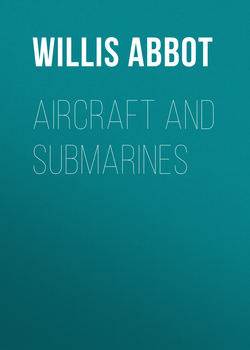Aircraft and Submarines

Реклама. ООО «ЛитРес», ИНН: 7719571260.
Оглавление
Abbot Willis John. Aircraft and Submarines
PREFACE
THE CONQUEST OF THE AIR
CHAPTER I. INTRODUCTORY
CHAPTER II. THE EARLIEST FLYING MEN
CHAPTER III. THE SERVICES OF SANTOS-DUMONT
CHAPTER IV. THE COUNT VON ZEPPELIN
CHAPTER V. THE DEVELOPMENT OF THE AIRPLANE
CHAPTER VI. THE TRAINING OF THE AVIATOR
CHAPTER VII. SOME METHODS OF THE WAR IN THE AIR
CHAPTER VIII. INCIDENTS OF THE WAR IN THE AIR
CHAPTER IX. THE UNITED STATES AT WAR
CHAPTER X. SOME FEATURES OF AËRIAL WARFARE
THE SUBMARINE BOAT
CHAPTER XI. BEGINNINGS OF SUBMARINE INVENTION
CHAPTER XII. THE COMING OF STEAM AND ELECTRICITY
CHAPTER XIII. JOHN P. HOLLAND AND SIMON LAKE
CHAPTER XIV. THE MODERN SUBMARINE
CHAPTER XV. ABOARD A SUBMARINE
ЯCHAPTER XVI. SUBMARINE WARFARE
CHAPTER XVII. THE FUTURE OF THE SUBMARINE
Отрывок из книги
It was at Mons in the third week of the Great War. The grey-green German hordes had overwhelmed the greater part of Belgium and were sweeping down into France whose people and military establishment were all unprepared for attack from that quarter. For days the little British army of perhaps 100,000 men, that forlorn hope which the Germans scornfully called "contemptible," but which man for man probably numbered more veteran fighters than any similar unit on either side, had been stoutly holding back the enemy's right wing and fighting for the delay that alone could save Paris. At Mons they had halted, hoping that here was the spot to administer to von Kluck, beating upon their front, the final check. The hope was futile. Looking back upon the day with knowledge of what General French's army faced – a knowledge largely denied to him – it seems that the British escape from annihilation was miraculous. And indeed it was due to a modern miracle – the conquest of the air by man in the development of the airplane.
General French was outnumbered and in danger of being flanked on his left flank. His right he thought safe, for it was in contact with the French line which extended eastward along the bank of the Somme to where the dark fortress of Namur frowned on the steeps formed by the junction of that river with the Meuse. At that point the French line bent to the south following the course of the latter river.
.....
The second trial for the Deutsch prize like the first ended in failure, but that failure was so much more dramatic even than the success which attended the third effort that it is worth telling and can best be told in M. Santos-Dumont's own words. The quotation is from his memoir, My Airships:
The later balloon "No. VI." with which Santos-Dumont won the Deutsch prize may fairly be taken as his conception of the finished type of dirigible for one man. In fact his aspirations never soared as high as those of Count Zeppelin, and the largest airship he ever planned – called "the Omnibus" – carried only four men. It is probable that the diversion of his interest from dirigibles to airplanes had most to do with his failure to carry his development further than he did. "No. VI." was 108 feet long, and 20 feet in diameter with an eighteen-horse-power gasoline engine which could drive it at about nineteen miles an hour. Naturally the aeronaut's first thought in his new construction was of the valves. The memory of the anxious minutes spent perched on the window-sill of the Trocadero Hotel or dangling like a spider at the end of the firemen's rope were still fresh. The ballonet which had failed him in "No. V." was perfected in its successor. Notwithstanding the care with which she was constructed the prize-winner turned out to be a rather unlucky ship. On her trial voyage she ran into a tree and was damaged, and even on the day of her greatest conquest she behaved badly. The test was made on October 1, 1901. The aeronaut had rounded the Tower finely and was making for home when the motor began to miss and threatened to stop altogether. While Santos-Dumont was tinkering with the engine, leaving the steering wheel to itself, the balloon drifted over the Bois de Boulogne. As usual the cool air from the wood caused the hydrogen in the balloon to contract and the craft dropped until it appeared the voyage would end in the tree tops. Hastily shifting his weights the aeronaut forced the prow of the ship upwards to a sharp angle with the earth. Just at this moment the reluctant engine started up again with such vigour that for a moment the ship threatened to assume a perpendicular position, pointing straight up in the sky. A cry went up from the spectators below who feared a dire catastrophe was about to end a voyage which promised success. But with incomparable sang-froid the young Brazilian manipulated the weights, restored the ship to the horizontal again without stopping the engines, and reached the finishing stake in time to win the prize. Soon after it was awarded him the Brazilian Government presented him with another substantial prize, together with a gold medal bearing the words: Por ceos nunca d'antes navegados ("Through heavens hitherto unsailed").
.....